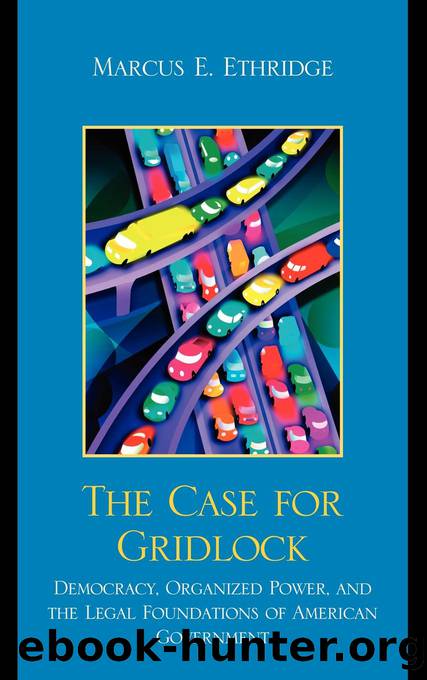The Case for Gridlock by Ethridge Marcus E.;

Author:Ethridge, Marcus E.;
Language: eng
Format: epub
Publisher: Lexington Books
Published: 2010-08-15T00:00:00+00:00
Conclusion
During the summer of 1968, an influential group of teachers and students of public administration attended a conference in Minnowbrook, New York, to discuss a movement they would call New Public Administration.54 Spiritual descendants of James Landis and Charles Groves Haines, these analysts claimed that their new approach amounted to a Kuhnian paradigm shift in the political theory of public administration. They wanted to dismantle the pillars of âtraditionalâ public administrationâexpertise, efficient management, central authority, and objectivityâand replace them with different principles. Instead of efficiency, administrative officials should pursue social equity. New Public Administration shared Landisâs taste for activist institutions, but they wanted to ensure that his administrative activism would predominantly serve Progressive policy goals.
New Public Administration would have only limited impact with respect to theoretical development in public administration. Its failure, however, is instructive. The architects of New Public Administration wanted to maintain and expand active, energetic administrative authority operating independently of the sluggish congressional-presidential system which they, like Progressives from a half-century before, felt was the bastion of status-quo elites: âAdministrators are not neutral. They should be committed to both good management and social equity as values, things to be achieved. . . .â (Frederickson 1971, p. 312).
Yet, unlike Landis and the other New Dealers, they were critical of what they saw as an administrative establishment so wedded to the ideals of neutral expertise and hierarchy that it could not be sufficiently sensitive to the environmental and egalitarian goals that were implicit in New Public Administrationâs partisan agenda. In short, they wanted both continued administrative independence from the Madisonian institutional system and selective (but coercive) supervision of administrators to ensure that they were pursuing social equity. The NPA movement was thus a crystallization of the incompatible objectives of the Second Stage reforms in administrative law.
The Second Stage reforms did not embrace the Constitutional Principle because they were designed to preserve administrative independence and the narrowly targeted political action it inevitably encourages. The representational problems of the administrative state were not solved by New Public Administration or the Second Stage reforms for the same reasons that Landisâs earlier vision of the administrative process proved ultimately disappointing to his generation. Tullockâs rent-seekers and Olsonâs distributional coalitions found that being effectively organized and oriented toward narrow policy goals was more politically profitable than ever because the Second Stage changes provided new ways for those with organizational strengths to work the system.
Many Progressives began to see that public participation in rule-making and âhard lookâ judicial review had not worked. Moreover, dramatic shifts in the national political scene during the 1980s brought the unsettled issues raised by the Second Stage to new heights of legal and political controversy. The institutional structure that largely defined the New Deal would increasingly serve a political agenda that previous supporters of administrative power could not accept. Administrative law would become shot through with inconsistencies and vagueness as modern Progressives and their newly vigorous opponents fought over the legal principles that shape the administrative state. The system that
Download
This site does not store any files on its server. We only index and link to content provided by other sites. Please contact the content providers to delete copyright contents if any and email us, we'll remove relevant links or contents immediately.
The Secret History by Donna Tartt(16662)
The Social Justice Warrior Handbook by Lisa De Pasquale(11494)
Thirteen Reasons Why by Jay Asher(7801)
This Is How You Lose Her by Junot Diaz(5799)
Weapons of Math Destruction by Cathy O'Neil(5046)
Zero to One by Peter Thiel(4834)
The Myth of the Strong Leader by Archie Brown(4795)
Promise Me, Dad by Joe Biden(4455)
Beartown by Fredrik Backman(4434)
Stone's Rules by Roger Stone(4423)
How Democracies Die by Steven Levitsky & Daniel Ziblatt(4414)
The Fire Next Time by James Baldwin(4350)
100 Deadly Skills by Clint Emerson(4085)
A Higher Loyalty: Truth, Lies, and Leadership by James Comey(4039)
Rise and Kill First by Ronen Bergman(4020)
The David Icke Guide to the Global Conspiracy (and how to end it) by David Icke(3891)
The Farm by Tom Rob Smith(3878)
Secrecy World by Jake Bernstein(3788)
The Doomsday Machine by Daniel Ellsberg(3737)
